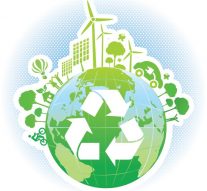
Which Strategy for EU to Reduce the Greenhouse Gas Emissions?
Energy 26 March 2018On the occasion of the last European Council, the Prime Ministers invited the Commission to present by the first quarter of 2019 a proposal for a Strategy for the reduction of long–term EU greenhouse gas emissions, in accordance with the Paris Agreement, taking into account the national plans.
The EU needs to transform its way of producing and consuming energy to drastically cut GHG emissions and deliver on the Paris Agreement. This transformation requires major investments in low–carbon assets and infrastructures. According to the Commission, about 379 billion euros investments are needed annually in the energy sector over the 2020-2030 period, mostly in energy efficiency, renewable energy sources and infrastructures.
Meeting these investment needs is challenging in the current economic environment. Despite the incipient economic recovery and a context of very low interest rates, private investment remains weak if compared to pre-crisis levels, and many Member States have limited budgetary margin of manoeuvre. In addition, investment in low carbon projects is hampered by various obstacles, ranging from the lack of effective carbon price to specific policy and technological risks or the existence of capacity gaps among potential project developers and investors.
There are many measures already in place, at both national and EU level, to support low–carbon project development and remove obstacles to low–carbon investments. However policy support measures are too often designed and carried out independently at different levels of governments, with little or no coordination. There are also serious concerns as regards cost-effectiveness, relevance and distributional impact of some of these policy instruments. There is hence potential to improve actions in support to low–carbon investment, through more coordination and harmonisation of national policy schemes, exchange of best practices and the expansion and improvement of existing EU programmes.
Dedicated public support instruments for low–carbon investment are just part of the response. A move towards a low–carbon economy will only be possible if there is a general re–allocation of capital from high–carbon to low–carbon assets and infrastructures. This requires the establishment of a common and effective carbon price covering all economic activities as well as the integration of climate considerations into all public and private investment decisions. Such a holistic approach to the financing aspects of the energy transition is gaining ground in Europe. A High–Level Group of independent experts has been recently set up to reflect on how to build up a sustainable financial system. It is important that the work of this Group leads to concrete and ambitious policy measures and that public investment decisions are aligned with the EU’s climate goals.
Finally, a key question for the years to come is how to distribute the financial cost of the transition. The energy transition will have positive effects on growth and employment, but in the short-term the measures put into place to decarbonise the energy system will ineluctably entail specific net costs for certain segments of the society, either in form of higher taxes and levies, stricter regulations or higher energy prices. Different political choices and measures can lead to a different distribution of the burden. It is crucial to take this into account and carefully handle the distributional consequences of these various measures, as only a fair distribution of costs can guarantee the political and social sustainability of this major long–term transformation.
The transition to a low–carbon economy will prompt major changes in the entire economy but the most important and transformative changes will be in the way of producing and consuming energy. This will require more and different types of investments in the energy sector. In particular, decarbonising the energy system encompasses more investment in renewables and less in conventional power (even if some is needed, at least temporarily, to guarantee back up capacity). It requires an expansion and better integration of EU’s electricity networks to adapt to a renewable-dominated energy market (with more intermittent, decentralised and geographically concentrated production). Finally, major investments are needed to improve the energy efficiency of all equipment, productive processes and infrastructures, in order to reduce the level of energy consumption in our economies.
A move towards a low–carbon energy system also implies a change in the components of energy costs, with a major increase in capital expenditures (CAPEX) and a decrease in operational expenditures (OPEX) and fuel purchases. This is because of two reasons. First, contrary to fossil-fuel power stations, renewable plants require high upfront capital costs but very low operating costs. Second, a growing deployment of renewables together with a reduction in energy consumption will logically entail a reduction in fuel purchase.
Europe’s strength in the energy transition lies in the drive of millions of citizens, consumers, local representatives, researchers, innovators, entrepreneurs and workers who make the energy transition a reality. EU mayors are also fully aware of the potential of this transition to reduce air pollution, traffic problems and to eradicate energy poverty. European wind power and energy efficiency companies are already world leaders in their field. We are already designing and manufacturing the clean energy solutions of today and tomorrow.
Europe has all the assets to succeed in its energy transition. We are the first in the world to have launched it and we have paved the way for other global powers, such as China, to commit to the cause through the Paris Agreement. The USA’s withdrawal from this Agreement further strengthens the European leadership and enables the EU to attract innovators and investors who understand the opportunity created by the energy transition.


